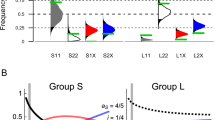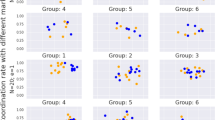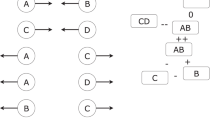Abstract
Members of some ethnic minorities are interested in the sustainability of certain cultural traits typical of their group. However, theoretical and empirical evidence suggests that sustaining such cultural variation can be difficult, given inter-ethnic interactions between groups differing in size, prestige and power. Here we examine the dynamics of cultural norms by constructing a model of interaction between members of minority and majority ethnic groups. We incorporate asymmetric coordination benefits to represent ethnic asymmetries in resource control and bargaining power. In the absence of other processes, we find that sustainability of minority cultural norms may be enhanced by establishing a group boundary that minority members can cross freely, but members of a powerful majority cannot. We show how model predictions can complement empirical studies of cultural change, and demonstrate the model’s relevance to our understanding of norm dynamics in an indigenous Amazonian population.
This is a preview of subscription content, access via your institution
Access options
Access Nature and 54 other Nature Portfolio journals
Get Nature+, our best-value online-access subscription
$29.99 / 30 days
cancel any time
Subscribe to this journal
Receive 12 digital issues and online access to articles
$119.00 per year
only $9.92 per issue
Buy this article
- Purchase on Springer Link
- Instant access to full article PDF
Prices may be subject to local taxes which are calculated during checkout


Similar content being viewed by others
References
Richerson, P. J. & Boyd, R. Not by Genes Alone: How Culture Transformed Human Evolution (Univ. Chicago Press, Chicago, IL, 2005).
Henrich, J. & McElreath, R. The evolution of cultural evolution. Evol. Anthropol. 12, 123–135 (2003).
Kopenawa, D. & Albert, B. The Falling Sky: Words of a Yanomami Shaman (Harvard Univ. Press, Cambridge, MA, 2013).
Nagel, J. American Indian Ethnic Renewal: Red Power and the Resurgence of Identity and Culture (Oxford Univ. Press, New York, NY, 1996).
Hornsey, M. J. & Hogg, M. A. Assimilation and diversity: An integrative model of subgroup relations. Pers. Soc. Psychol. Rev. 4, 143–156 (2000).
Aikman, S. La Educación Indígena en Sudamérica: Interculturalidad y Bilingüismo en Madre de Dios, Perú (IEP Ediciones, Lima, 2003).
Baer, G. Comes carne de armadillo? Acerca del problema de la identidad de los Matsiguenka del Bajo Urubamba en el Oriente Peruano. Bol. de Antropol. (Univ. de Antioquia) 18, 317–336 (2004).
Jackson, J. Is there a way to talk about making culture without making enemies? Dialect. Anthropol. 14, 127–143 (1989).
Jackson, J. Culture, genuine and spurious: The politics of Indianness in the Vaupés, Colombia. Am. Ethnol. 22, 3–27 (1995).
Beheim, B. A. & Baldini, R. Evolutionary decomposition and the mechanisms of cultural change. Cliodynamics 3, 217–233 (2012).
Kolodny, O., Creanza, N. & Feldman, M. W. Evolution in leaps: The punctuated accumulation and loss of cultural innovations. Proc. Natl Acad. Sci. USA 112, E6762–E6769 (2015).
Krauss, M. The world’s languages in crisis. Language 68, 4–10 (1992).
Berry, J. W. Immigration, acculturation, and adaptation. Appl. Psychol. 46, 5–34 (1997).
Brewer, M. B. The social self: On being the same and different at the same time. Pers. Soc. Psychol. Bull. 17, 475–482 (1991).
United Nations General Assembly United Nations Declaration on the Rights of Indigenous Peoples A/RES/61/295 (United Nations, 2007).
Gans, H. J. Symbolic ethnicity: The future of ethnic groups and cultures in America. Ethn. Racial Stud. 2, 1–20 (1979).
Barth, F. in Ethnic Groups and Boundaries: The Social Organization of Culture Difference (ed. Barth, F.) 9–38 (Waveland Press, Long Grove, 1998).
Wimmer, A. Ethnic Boundary Making: Institutions, Power, Networks (Oxford Univ. Press, Oxford, 2013).
Inglehart, R. & Baker, W. E. Modernization, cultural change, and the persistence of traditional values. Am. Sociol. Rev. 65, 19–51 (2000).
Bell, A. V. The dynamics of culture lost and conserved: Demic migration as a force in new diaspora communities. Evol. Hum. Behav. 34, 23–28 (2013).
Bunce, J. A. & McElreath, R. Interethnic interaction, strategic bargaining power, and the dynamics of cultural norms: A field study in an Amazonian population. Hum. Nat. 28, 434–456 (2017).
McElreath, R., Boyd, R. & Richerson, P. J. Shared norms and the evolution of ethnic markers. Curr. Anthropol. 44, 122–130 (2003).
Boyd, R. & Richerson, P. J. The evolution of ethnic markers. Cult. Anthropol. 2, 65–79 (1987).
Boyd, R. & Richerson, P. J. Group selection among alternative evolutionarily stable strategies. J. Theor. Biol. 145, 331–342 (1990).
Gilpin, W., Feldman, M. W. & Aoki, K. An ecocultural model predicts Neanderthal extinction through competition with modern humans. Proc. Natl Acad. Sci. USA 113, 2134–2139 (2016).
Henrich, J. & Gil-White, F. J. The evolution of prestige: freely conferred deference as a mechanism for enhancing the benefits of cultural transmission. Evol. Hum. Behav. 22, 165–196 (2001).
Boyd, R. & Richerson, P. J. Group beneficial norms can spread rapidly in a structured population. J. Theor. Biol. 215, 287–296 (2002).
Boyd, R. & Richerson, P. J. Voting with your feet: payoff biased migration and the evolution of group beneficial behavior. J. Theor. Biol. 257, 331–339 (2009).
Pisor, A. C. & Gurven, M. Risk buffering and resource access shape valuation of out-group strangers. Sci. Rep. 6, 30435 (2016).
Sahlins, M. in Culture/Power/History: A Reader in Contemporary Social Theory (eds Dirks, N. B. et al.) 412–455 (Princeton Univ. Press, Princeton, NJ, 1994).
Solway, J. S. & Lee, R. B. Foragers, genuine or spurious? Situating the Kalahari San in history. Curr. Anthropol. 31, 109–146 (1990).
Wolf, E. R. Europe and the People Without History (Univ. California Press, Berkeley, CA, 1982).
Ross, R. M. & Atkinson, Q. D. Folktale transmission in the Arctic provides evidence for high bandwidth social learning among hunter–gatherer groups. Evol. Hum. Behav. 37, 47–53 (2016).
Bicchieri, C. The Grammar of Society: The Nature and Dynamics of Social Norms (Cambridge Univ. Press, Cambridge, 2006).
Young, H. P. The evolution of social norms. Annu. Rev. Econ. 7, 359–387 (2015).
Nave, A. Marriage and the maintenance of ethnic group boundaries: The case of Mauritius. Ethn. Racial Stud. 23, 329–352 (2000).
Shepard, G. H. Jr., Rummenhoeller, K., Ohl, J. & Yu, D. W. Trouble in paradise: Indigenous populations, anthropological policies, and biodiversity conservation in Manu National Park, Peru. J. Sustain. For. 29, 252–301 (2010).
Moffett, M. W. Human identity and the evolution of societies. Hum. Nat. 24, 219–267 (2013).
McElreath, R. & Boyd, R. Mathematical Models of Social Evolution: A Guide for the Perplexed (Univ. Chicago Press, Chicago, IL, 2007).
Gluckman, M. Papers in honor of Melville J. Herskovits: gossip and scandal. Curr. Anthropol. 4, 307–316 (1963).
Wiessner, P. Norm enforcement among the Ju/’hoansi Bushmen: A case of strong reciprocity? Hum. Nat. 16, 115–145 (2005).
Carvalho, J.-P. Coordination and culture. Econ. Theory 64, 449–475 (2017).
Kuran, T. & Sandholm, W. H. Cultural integration and its discontents. Rev. Econ. Stud. 75, 201–228 (2008).
Patriarca, M. & Heinsalu, E. Influence of geography on language competition. Physica A 388, 174–186 (2009).
Kandler, A. Demography and language competition. Hum. Biol. 81, 181–210 (2009).
Moya, C. & Boyd, R. Different selection pressures give rise to distinct ethnic phenomena. Hum. Nat. 26, 1–27 (2015).
Basso, K. H. in Senses of Place (eds Feld, S. & Basso, K. H.) 53–90 (School of American Research Press, Santa Fe, NM, 1996).
Santos-Granero, F, in Tierra Adentro: Territorio Indígena y Percepción del Entorno (eds Surallés, A. & García Hierro, P.) 187–217 (IWGIA, Copenhagen, 2004).
Acknowledgements
A. Kandler helped to develop the model in Supplementary Discussion B.4. A question by M. Borgerhoff-Mulder inspired the model in Supplementary Discussion B.5. B. Beheim helped with the derivation of equation (7). A. Pisor, A. Kandler, C. Moya, B. Purzycki, C. Ross, C. Revilla and the staff of the Department of Human Behavior, Ecology, and Culture at the Max Planck Institute for Evolutionary Anthropology, as well as the Human Behavioral Ecology Lab Group at the University of California, Davis, provided valuable comments and criticism on earlier versions of this paper. Any error in word, math, or script is ours. Funding was provided by the U.S. National Science Foundation (BCS 1227152) to J.A.B., and by the Max Planck Society. The funders had no role in study design, analysis, decision to publish, or preparation of the manuscript.
Author information
Authors and Affiliations
Contributions
J.A.B. and R.M. designed the research. J.A.B. performed the analysis. J.A.B. and R.M. wrote the paper.
Corresponding author
Ethics declarations
Competing interests
The authors declare no competing interests.
Additional information
Publisher’s note: Springer Nature remains neutral with regard to jurisdictional claims in published maps and institutional affiliations.
Supplementary information
Supplementary Information
Supplementary Methods, Supplementary Files 1–8, Supplementary References 1–7, Supplementary Tables 1–2.
Rights and permissions
About this article
Cite this article
Bunce, J.A., McElreath, R. Sustainability of minority culture when inter-ethnic interaction is profitable. Nat Hum Behav 2, 205–212 (2018). https://doi.org/10.1038/s41562-018-0306-7
Received:
Accepted:
Published:
Issue Date:
DOI: https://doi.org/10.1038/s41562-018-0306-7
This article is cited by
-
Intergroup Cooperation in Shotgun Hunting Among BaYaka Foragers and Yambe Farmers from the Republic of the Congo
Human Nature (2023)
-
Distinguishing Intergroup and Long-Distance Relationships
Human Nature (2022)
-
Ethnic Markers without Ethnic Conflict
Human Nature (2021)
-
Ethnic Markers and How to Find Them
Human Nature (2021)
-
The Evolution of Covert Signaling
Scientific Reports (2018)



